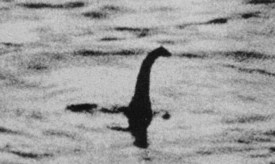For decades they have delved into the murky deep to explore the mystery of the elusive Nessie.
Now an expert from St Andrews University is shedding light on the history of Loch Ness Monster spotters.
Statistical ecologist Dr Charles Paxton is working on the first catalogue of all known sightings of the Loch Ness monster in modern times and will present his findings at a conference this weekend as part of the Edinburgh International Science Festival.
It marks the 80th anniversary of the first official sighting of Nessie. It was in April 1933 that Drumnadrochit hotel manageress Aldie Mackay reported “something resembling a whale” while on the road from Inverness.
The research fellow, who will publish his findings later this year, is analysing all reported sightings for consistencies or patterns which could be explained by natural phenomena.
He is specifically looking for clusters in terms of what is reported.
“In some cases there are multiple witnesses, or witnesses giving multiple accounts of the same event, which allow us to test eyewitness consistency.”
There have been more than 1,000 recorded sightings of Nessie and Dr Paxton has so far sifted through more than 800.
Although he wryly notes several hotel proprietors among the spotters, he said: “Everyone sees Nessie, from aristocrats and celebrities such as Gavin Maxwell and Compton Mackenzie to ordinary folk.
In some cases, spotters saw Nessie more than once, as Dr Paxton noted: “These cases are very interesting because they allow us to consider whether certain witnesses have a tendency to see Nessie more than might be expected by chance alone.”
He has looked at newspaper clippings, reports, books and records from the Loch Ness Investigation Bureau of the 1960s and 1970s.
“Although the first recorded sighting of a monster-like creature at Loch Ness was by St Columba in 565AD, it was Mrs Mackay’s sighting in 1933 that launched the myth.
“In 1933-1934 the Loch Ness Monster became a massive global phenomena.”
